I have to say I was somehow reluctant, when considering this dress. I love smocking, but not areas that big. It takes quite long, and it’s always the same stitch, so it can get boring. And all for a dress where very few can sense the difference between the aliexpress costume and something properly made.
I have seen many making this costume. When I pass the whole time thinking about what I could make better in my mind, I kind of hate myself, because I agreed long ago that I wouldn’t be one of those people who always think they can do better, but they never prove it. I promised myself that I would actually make things, before stating I could do better without even trying. Things are always much more perfect in our minds, and when we make them we might encounter other problems and make entirely new mistakes.This was why I made Arwen’s dress, and this is why I made this.
I wanted to wear the dress at Volta in Cosplay, a photographic convention, where it’s all about scheduling shootings with phtoographers you like, in the whole town and surrounding area, with access to many delightful locations.
The dress wasn’t easy, but it was not even so hard that I wasn’t confident about finishing it on time. And it was a dress I had a back-up for. The wedding dress could have been easily used without making the photographers re-program everything about locations and lights.
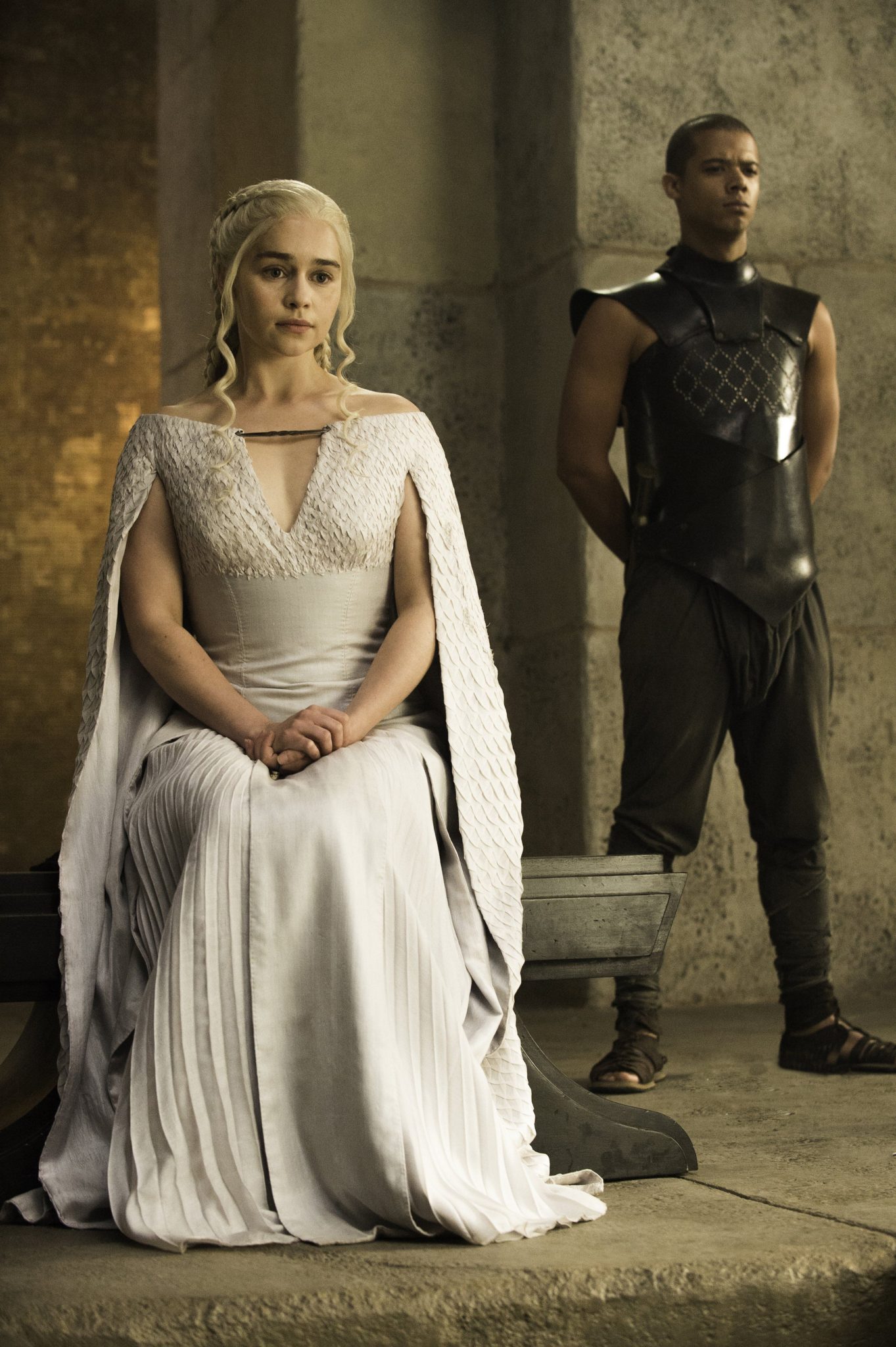
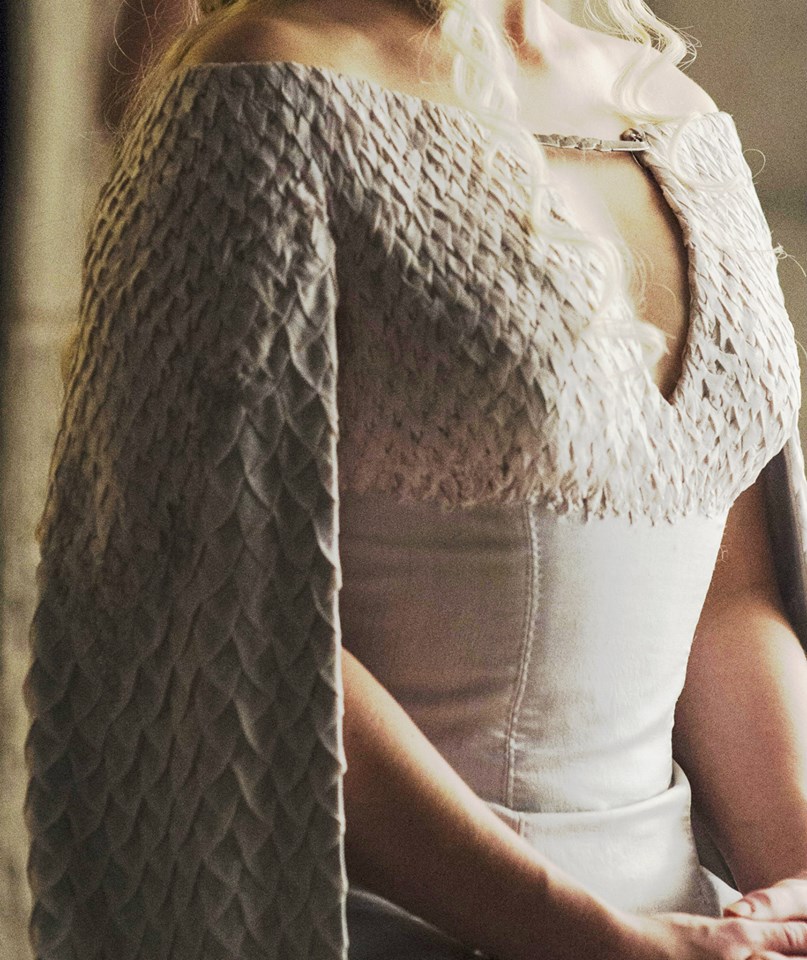
Let’s try to read the dress together. Sometimes I think in many just see a white dress with some texture in some spots, so follow me through this part to discover details and tricks that will allow you to see where the accuracy lies.
Most of the images come from this page: Game of thrones costuming references. It is a page I created some years ago. At the beginning I had some help, now I am the only one updating it, so I basically update Dany’s and Cersei’s costumes only.
The dress has a sunray pleated skirt underneath. Over it, there’s a smooth base in a lightly shiny and uneven material, reaching the floor. Two seams divide the front of the bodice below the bust, and from each one a split starts, showing the skirt. At each side of the seam there’s a line of backstitching in the same colour, each stitch is a very tiny point, and each one is more or less three millimeters from the following one. The dress reaches the floor.
The bust is covered in an other fabric, in the same colour, perfectly smooth and lightly transparent, with a crispy texture, smocked with the dragonscale pattern shown in Michele Carragher’s website (triangular smocking).The neckline is straight, just below the collarbones, with a V opening at the center, reaching 2/3 of the space between the rest of the neckline to the underbust line where the smocking ends. The smocked part covers the cape-sleeves at the top, in a V shape, and at the sides of the bust it stops at the underarm seam.
At each side there’s a cape-like sleeve, starting from the armpit line and reaching almost the center at the back. The sleeve reaches the floor. At the back it has two pleats. The inside is lined in a smooth fabric in the same colour, and the outside is covered in the same fabric used for the smocking, pleated with the reverse chevron pattern.
The V part of the neckline is closed by a barrette brooch, in the shape of a twisted rope, in dark metallic grey. The design looks flat, like it’s hammered. The sides are thinner and end with a hook.
There’s no visible machine stitching or machine topstitching.
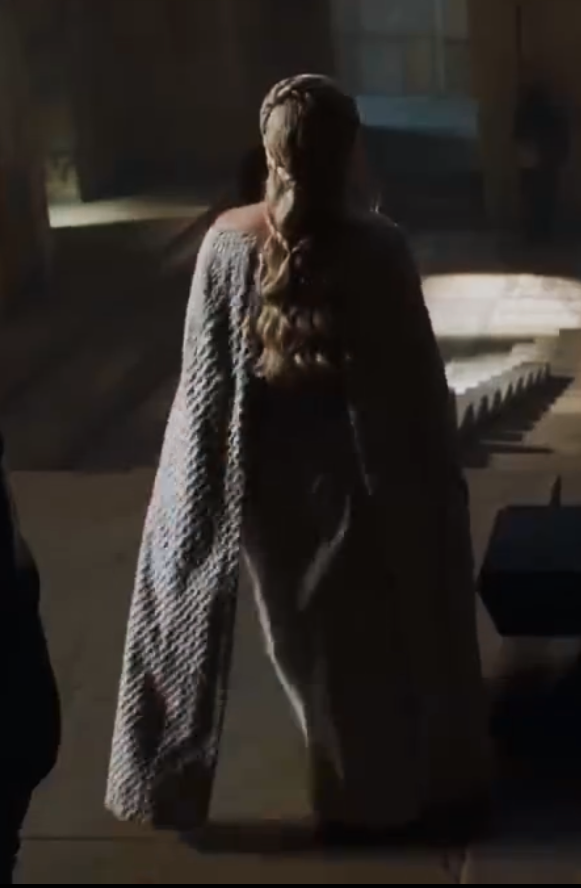
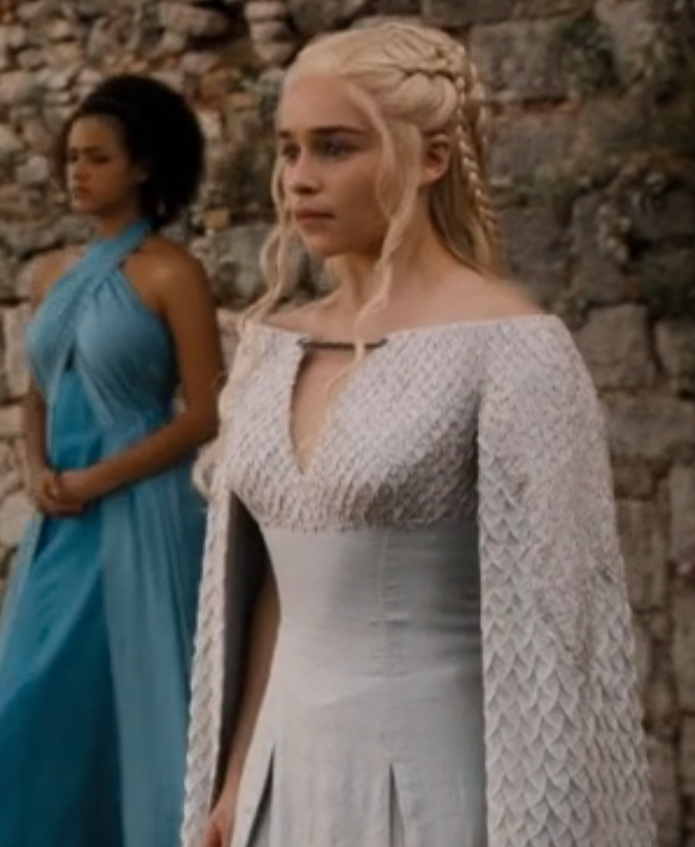
The colour is matter of debate. Everyone si making this dress white. But I don’t think it is.
“This season she wears a lot of white and dove grey. “Now she’s got this sense of power and also a sense of immortality,” Clapton says. “I wanted to give this rather untouchable [quality] to her. The idea behind the white and pale grey is the sense of removal, a removal from reality.”
There’s a secret underneath all those gowns, too. “I still always put trousers underneath because in her psyche anything might go wrong and [she’s always thinking], ‘I might need to run away,'” Clapton says. “Even with the longest, most beautiful gowns, she always wears a pair of boots and trousers. I like that sense of, ‘I can play this [queen] but underneath, I can run”.
The image given for this text is the following one.
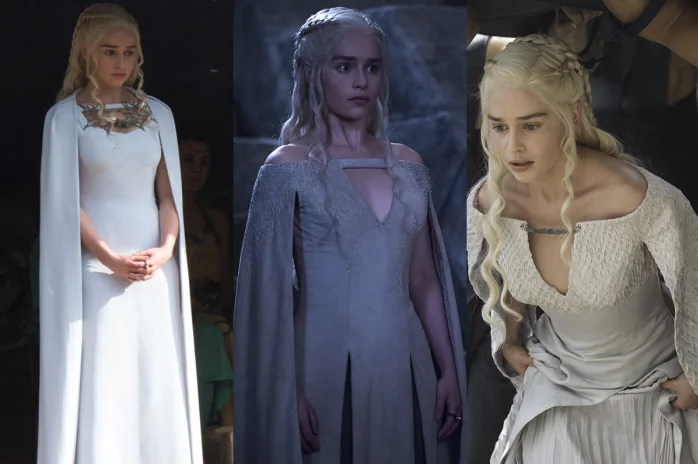
The first one is snow white. The third one is not. There’s further evidence on that, in the cover of a magazine, where Clarke poses with Dinklage.
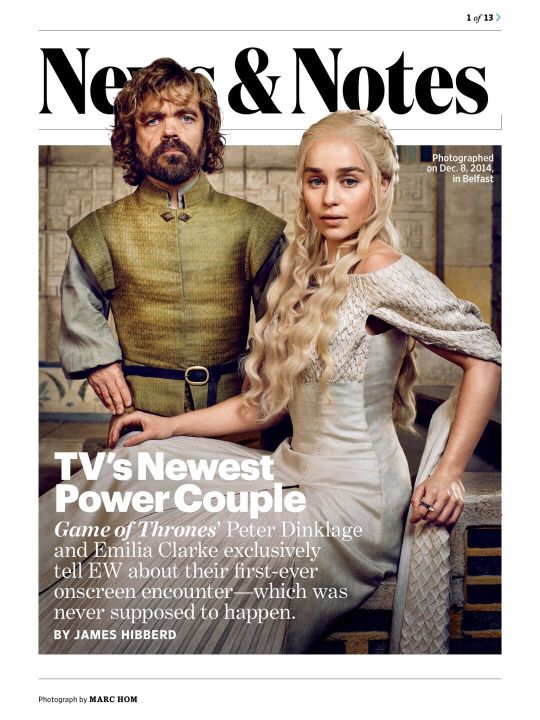
White? This is not.
One of the other things I’ve seen in commercial costumes and that I thought I could make better was the skirt. It’s very full and reaches the floor, while I see very often those cheap pleated skirts, sometimes even in satin, while the original one is matte.
The smocking is sometimes replaced with diamond-stitched stuff, as it’s done with the pleated part.
I think all of her costumes, or most of them, are boned and stiffened. I usually see this costume recreated with a very soft effect. Which looks good when the thing is placed on the mannequin, but not so much when it’s worn.
I also see the front V turning to a U.
Basically, the dress is not stiffened enough with flatlined parts and boning. The thing I usually hear is “you see, there are no seams that show the bodice is boned”. Because in many think that to add a bone you necessarily need to sew the channel by machine through the fabric. Victorian bodices though often have boning with no machine stitching visible, and some of them do not match any outer seam. This can be accomplished by flatlining the outer fabric and sewing the bone to the inner fabric only.
I am also a fan of flatlining everything. You can have the look of silk chiffons and satin, and the shape of taffeta, the softness of flannel over the structure of coutil. The outer fabric gives the look, the inner one the structure. This is something extremely overlooked, but can give your work a very different look.
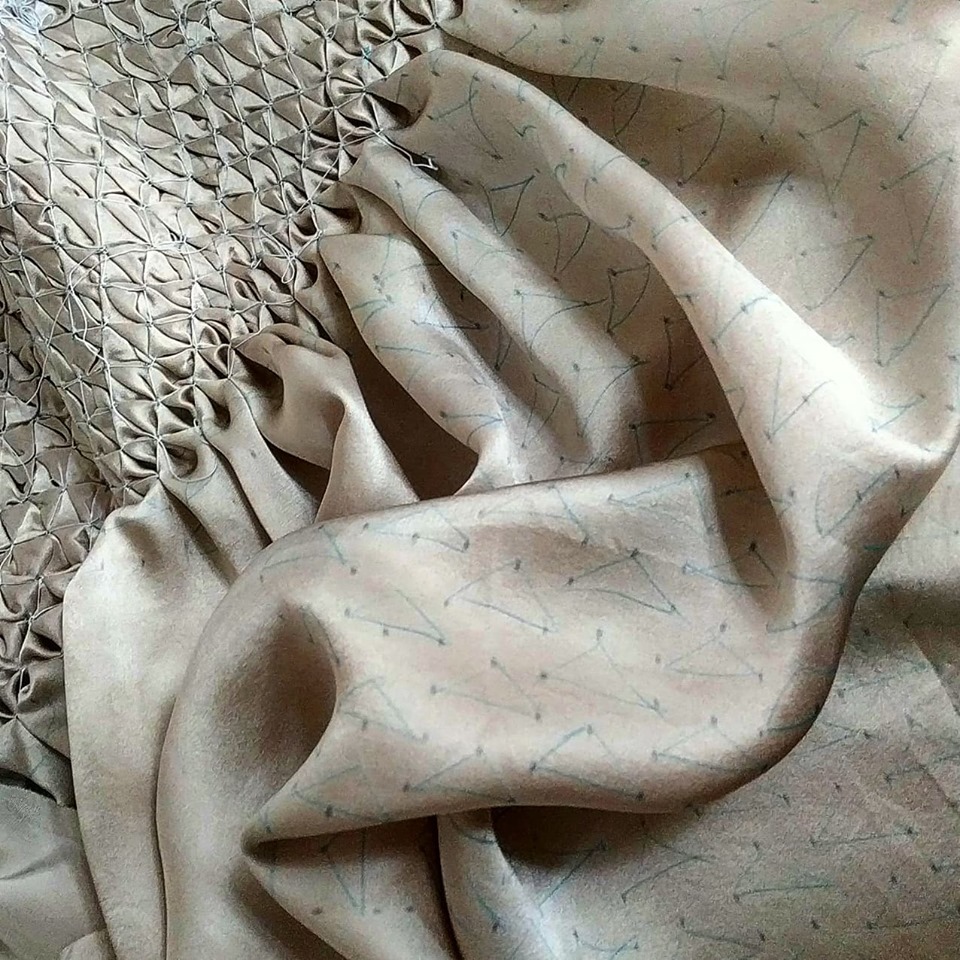
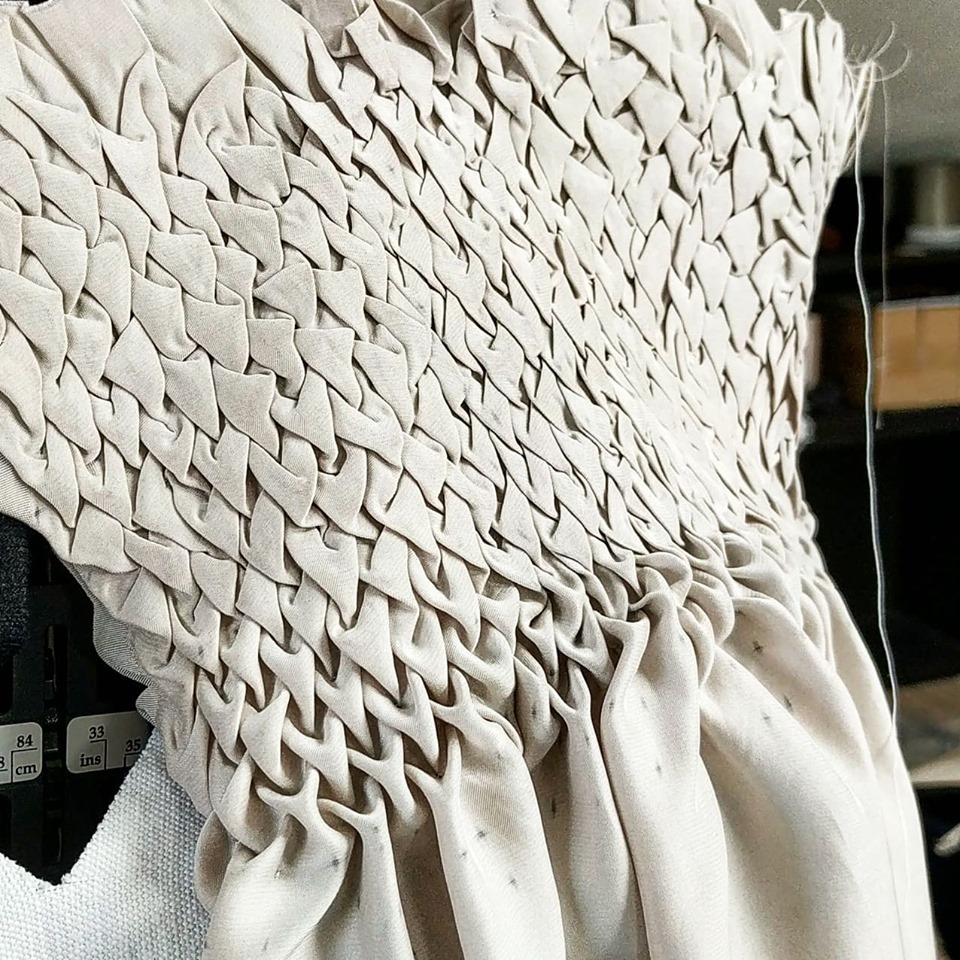
Now to the materials.
The original one has three visible materials: main fabric, skirt fabric, outer side of the sleeves and upper bodice fabric.
The main fabric really looks like the usual silk-linen blend of her blue dresses. The smocking one should be tissue silk. I have no idea what the skirt is made of, but it’s light, not sheer, and matte.
I purchased a quite expensive silk-linen blend for the dress. It turned out to have too much linen, and it wasn’t shiny as I wanted it. But I had to work with it, due to time issues and lack of alternatives found online. This is why I hate to make replica costumes I never made before with a real deadline. Making a costume with the perfect fabric can require months to find it, or even years. There are some of my costumes that were planned long before, but I couldn’t start because I didn’t have the perfect fabric, and fabric is the ingredient to make the dress. It’s like making an apple pie with pears. If you don’t have apples, you don’t make an apple pie, you can make a pie, but it’s not an apple pie, and you can make one in the right season.
However the fabric could have worked, it was very close, except for the shiny finish, so I used it. I still plan on waxing it a bit, to see if it can do the trick and make it look closer to the real thing.
I had some troubles with the fabric for the texturised parts too. The first silk I ordered was crisp and lightly sheer, and perfect from the pictures, but got here with little stripes woven in. Due once again to lack of time, I purchased a lot of silk satin, and used it on the reverse side. Not the cheapest option, but I knew what would have arrived in the mailbox.
The skirt had to be pleated. Which means that the pleats are set with heat. As for real and fake hair, natural fibers don’t hold the heat-given shape in case of contact with water, while synthetics can be washed, as long as it’s cold. And as this is something supposed to touch the floor, I wanted it to be a bit more long-lasting. It was the perfect chance to use a third fabric that arrived wrong for an other project.
I dyed all the fabrics in a similar shade. I had to send the skirt to be pleated before I got the rest of the fabrics, so they came out of two different dye baths and have slightly different shades. And being the skirt in polyester, it required a much stronger dye to get the same colour when not heated. Because yes, I dyed it after it was pleated. I knew it could not work and I took my risk. DO NOT DO IT YOURSELF.
I had everything pleated by Ciment Pleating. They did the red cape from season 7, though they confessed they didn’t work on this costume too. This is why their mould for the pleats used for the sleeves has a slightly smaller pattern than the one on the real costume. But I think very few would notice. I contacted some local pleating companies, which refused to pleat only two panels or stopped writing back. So I had no alternative. After all, if you want it like the original, there’s nothing you can do by hand to have a look this close. You have to have it pleated. In the end the result was magnificent and very close.
The skirt looks so rich, and I had more fabric, so I decided to give three half circles instead of just two. I ended up with a very rich skirt I am very fond of. Though it gets very hard to pick up when I need to climb the stairs.
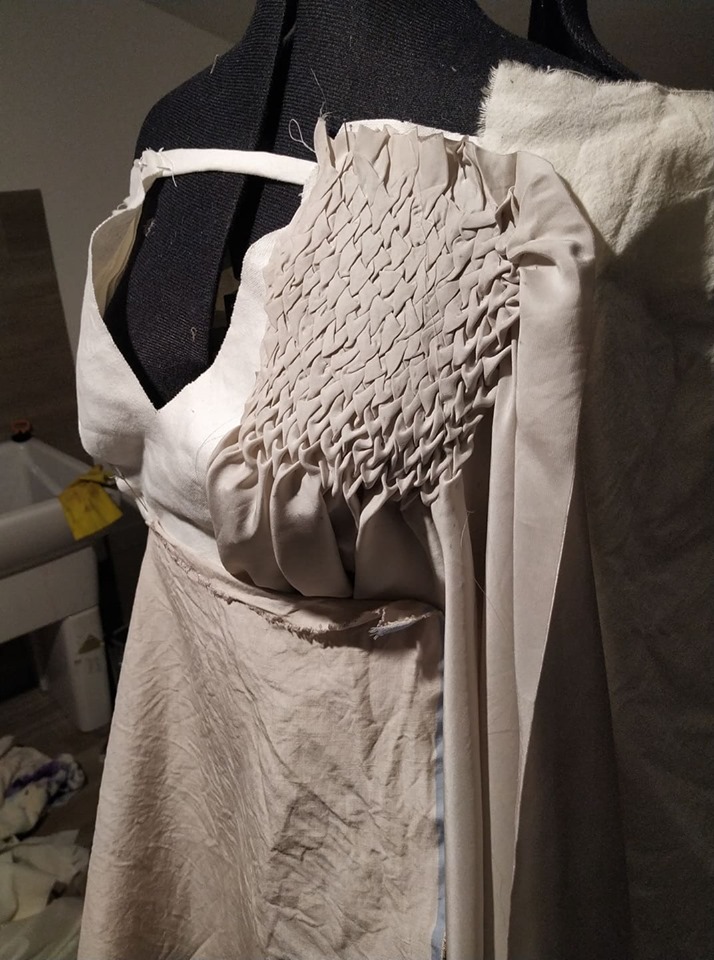
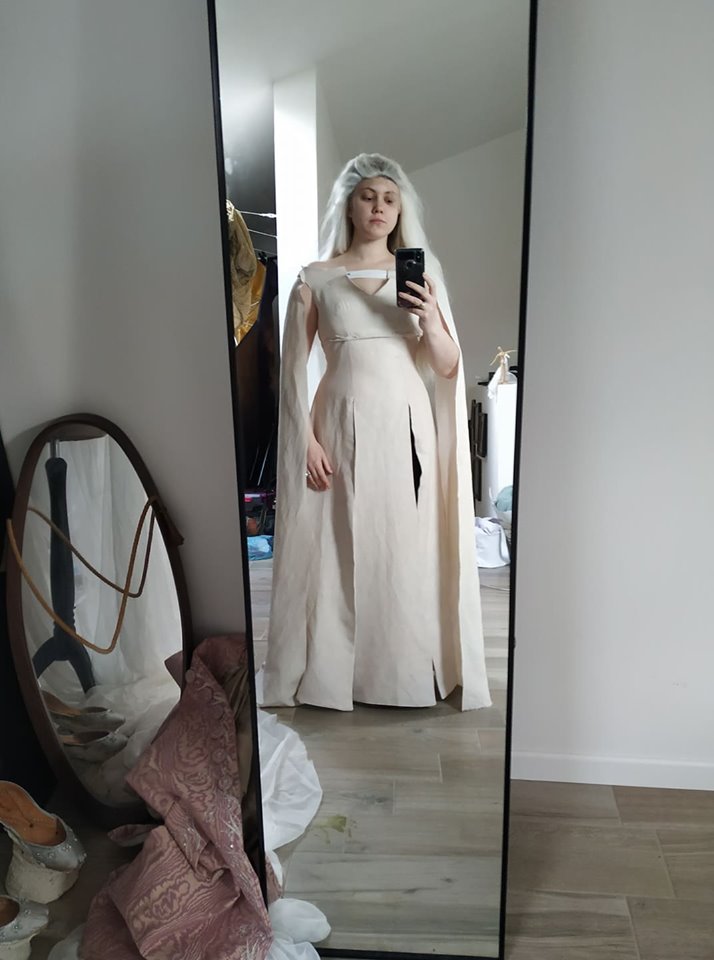
I had a mock-up. Something with such a tight fit has to be tested, especially if you don’t have the luxury of enough time to remake it, or enough fabric.
I added some boning. At the seams only, for the moment, and at the sides of the V. I want to add more. Just two bones don’t hold the V in place. I pierced the synthetic whalebone and sewn it through, to keep it from flipping, but it’s not working well enough. I will probably add more boning there, and at the center of the underbust-to-waist part. The orginal wrinkles too when she sits, but I don’t like it. I like my fabric as controlled as I can have it, when we’re talking about flat parts. I might need to add some flannel in between, not to see the shadow of the bones. It means taking the whole dress apart, so I am not sure yet.
I don’t know why in so many wear this dress low, off the shoulders. It has a very distinctive neckline, just below the collarbones, and around the top of the acromion process of the scapula (shoulder blade). Like victorian bodices. The trick is that it is slightly smaller than the widest part of the shoulder, which is what keeps it up. Otherwise the dress doesn’t have where to “hold” and without a lot of structure tricks it collapses on itself. To stand up, it would need to be built as a proper corset, while with the neckline as in the original it needs just a bit of support.
This comes very useful when you consider the sleeves! They are tricky. The shape is simple, but they are kind of heavy (fabric is light, but there’s lots of it, especially in the pleated parts), so they pull the soulders down as soon as they’re given the chance.
This makes my bodice and sleeves stay up, and if you look closer to the original, it’s the same. It’s not off the shoulders, though it might seem so, at the first look. It’s a very wide boat neckline, if we consider the barrette at the front to continue the line. And it does, because without that piece, the shoulders are pulled off.
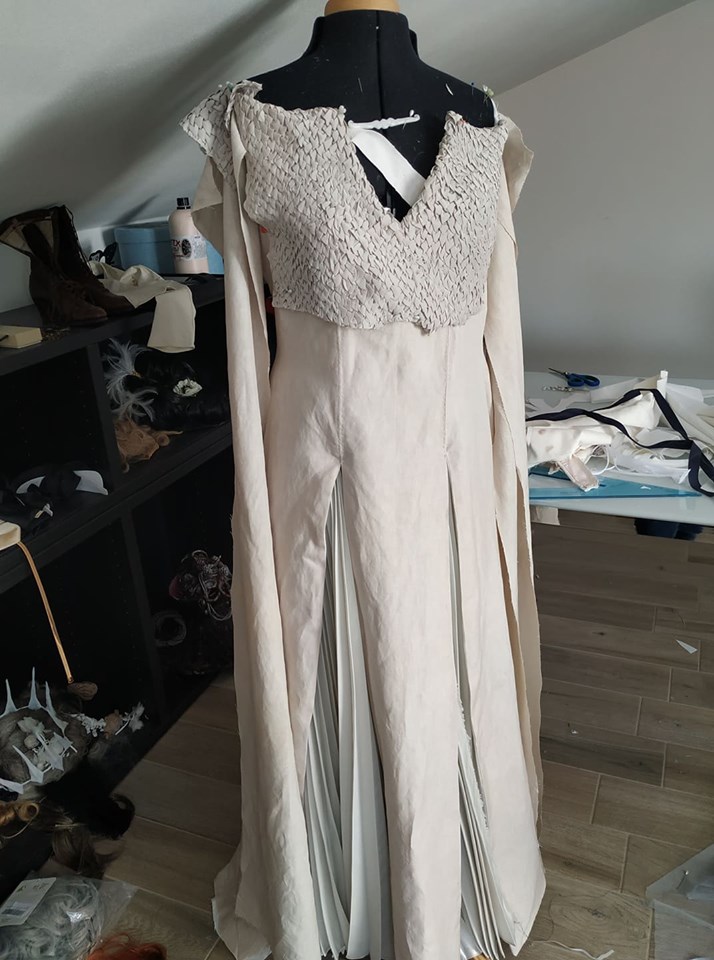
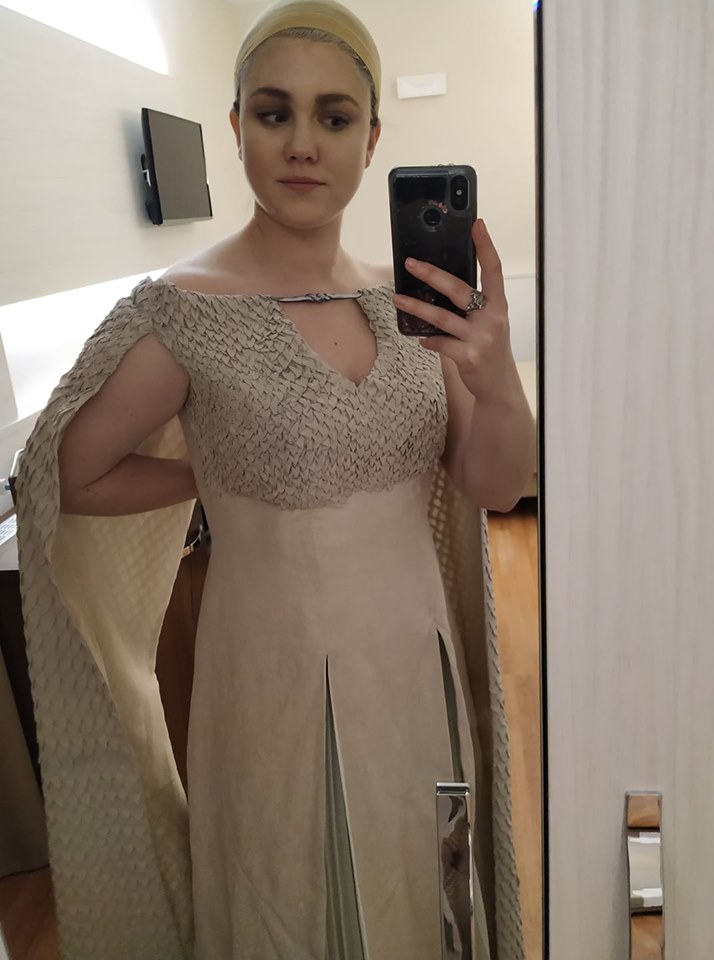
The pleated parts of the sleeves arrived the day before the Con started, so I attached them at the hotel. I added the smocked parts (the fabric wasn’t enough to make those as low as in the original, but I didn’t expect the pleating to need this much fabric when I ordered the satin) and then the silver emrboidery you can barely see in some stills from the show.
Now to the most important part of the thing, to me: what can I improve?
On materials, if I made a new one, I’d have an other fabric, just for that shiny effect. Though I might wax this one. I’d also get paper silk, because the scales get much sharper and crispier. What I used is always silk, so it’s not bad, it holds the shape, but it’s still not “it”, just “very much like it”.
I have to adjust the shape of the front panels. The original has those two seams curving outwards at the top, while mine don’t, as they follow the inner boning. At this point, seeing how her bust is shaped from the side pictures, I think she has a proper corset underneath this one, and that it’s not just boned like they say the others are.
The colour of mine is slightly too beige. I need something grey-ish, less brown.
The cape-sleeves are too far from the bodice at the front. And are somehow gathered, the pleated part is gathered where it joins the smocked one, so the sleeves seem to flare a bit.
The smocked part on the sleeves needs to be bigger. At least twice as big. And I might need a darker thread for the embroideries.
I need to adjust the hem of both skirt and sleeves. But considering I finished those at the hotel, without a mannequin or anyone able to help me wear the dress and mark the hem, I can’t complain.
The dress looked by far more than fine to me, for being my first attempt. Needs improvements, but I am quite pleased.
* EDIT: the costume was at one exhibit, this is the image I’ve found:
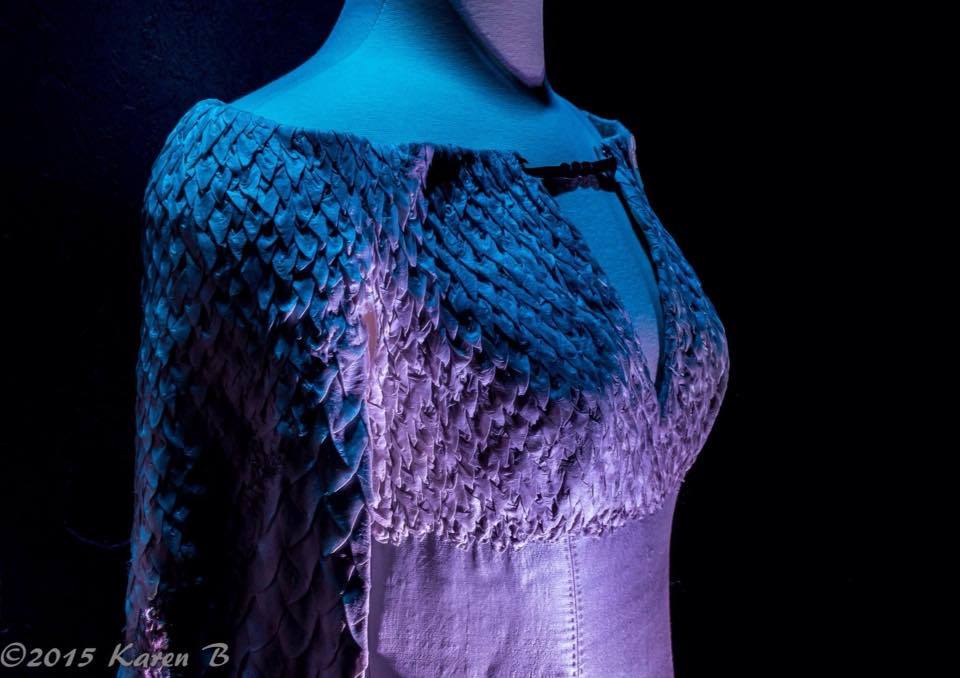

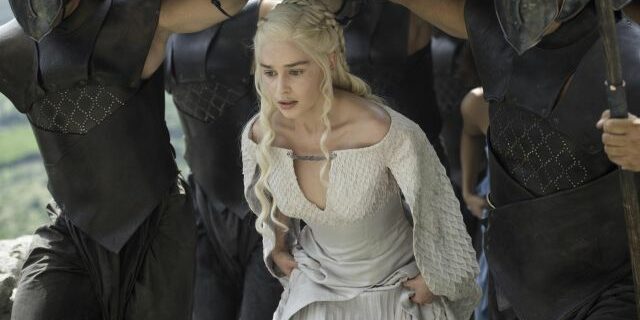






hi! i’m making this costume too! I was wondering how far apart your smocking scales were? I tried 1cm, but it ate up so much material that it was wasteful. any ideas? thank you! -maggie
Hi!
It does need a lot of material. Three times in width and two in height, at least 🙂
Oh my gosh you did an amazing job!